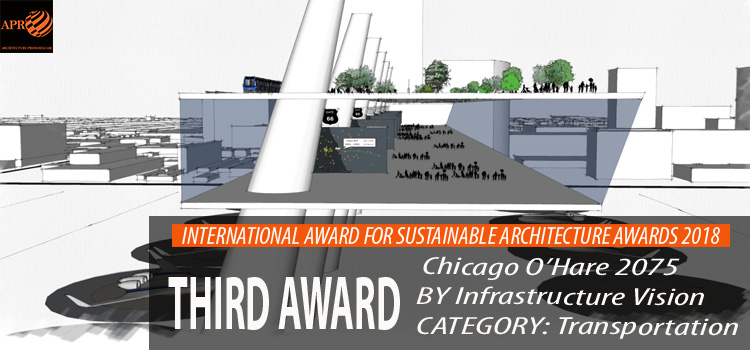Congestion and pollution are among the most critical issues faced
by cities around the world. This vision for Chicago O’Hare International
Airport is based on the conviction that sustainability is not only
about the direct environmental measures, it is also about how we design
and use our infrastructure.

‘O’Hare 2075’ envisages Chicago’s future airport based on a design philosophy of ‘reducing space by combining functions’. The airport will serve as a city bridge (1) in addition to its functions as an airport terminal (2). Moreover, airport-related processes have been combined as much as possible. Chicago subway outstations will collect passengers which proceed through the security filter incorporated in the subway. In essence, screening occurs simultaneously while travelling towards the airport, whereas previously both processes could be considered as wasted time. Furthermore, offsite security means no area for security is required at O’Hare terminal, lowering the footprint of the infrastructure.



By refining the airport as a whole, O’Hare will enable optimal use of scarce space, typical for future cities where airports are circumvented by urbanisation. The combination of the respective innovations creates a more sustainable terminal which will become a natural part of the living environment.


International Award for Sustainable Architecture Awards 2018
Third Award | Category: Transportation
Architects: Sebastiaan Menger
Studio Name: Infrastructure Vision
Country: The Netherlands
‘O’Hare 2075’ envisages Chicago’s future airport based on a design philosophy of ‘reducing space by combining functions’. The airport will serve as a city bridge (1) in addition to its functions as an airport terminal (2). Moreover, airport-related processes have been combined as much as possible. Chicago subway outstations will collect passengers which proceed through the security filter incorporated in the subway. In essence, screening occurs simultaneously while travelling towards the airport, whereas previously both processes could be considered as wasted time. Furthermore, offsite security means no area for security is required at O’Hare terminal, lowering the footprint of the infrastructure.
By refining the airport as a whole, O’Hare will enable optimal use of scarce space, typical for future cities where airports are circumvented by urbanisation. The combination of the respective innovations creates a more sustainable terminal which will become a natural part of the living environment.
If you’ve missed participating in IASA 2018, you don’t need to worry. APR’s next award Urban Design & Architecture Design Awards 2018 is open for Registration.

Good Post! Thank you so much for sharing this pretty post, it was so good to read and useful to improve my knowledge as updated one, keep blogging.
ReplyDeleteSecurity Infrastructures Designing
Business Network Infrastructure Designing
This comment has been removed by the author.
ReplyDeleteTo obtain a debt managment companies license, a company or individual typically must meet certain requirements, which may vary depending on the jurisdiction. These requirements may include passing a background check, completing a certain amount of training or education, and demonstrating financial stability.
ReplyDelete